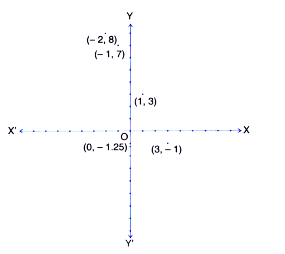NCERT Solutions for Exercise 3.3 Class 9 Maths Chapter 3 - Coordinate Geometry
Till now in question the points have already been marked and we have been asked to tell the coordinates but in NCERT Solutions for Class 9 Maths chapter 3 exercise 3.3. We have been given points to plot on the plane; for example, if we were given a point to plot in the cartesian plane, the first step would be to draw coordinate axes, and then we would choose a scale for the coordinate axis, such as 1 centimeter.
This Story also Contains
- Coordinate Geometry Class 9 Chapter 3 Exercise: 3.1
- More About NCERT Solution for Class 9 Maths Chapter 3 Exercise 3.3
- Benefits of NCERT Solutions for Class 9 Maths Exercise 3.3
- NCERT Solutions of Class 10 Subject Wise
- Subject Wise NCERT Exemplar Solutions
NCERT book Class 9 Maths exercise 3.3 is a foundation exercise for the branch of coordinate geometry as well as all of the chapters that will be covered in subsequent sessions. The following activities are included in Class 9 Mathematics chapter 3 exercise 3.3.
Coordinate Geometry Class 9 Chapter 3 Exercise: 3.1
Answer:
(-2,4) lies in second quadrant
(3,-1) lies in fourth quadrant
(-1,0) lies in second quadrant
(1,2) lies in first quadrant
(-3,-5) lies in third quadrant
| x | -2 | -1 | 0 | 1 | 3 |
| y | 8 | 7 | -1.25 | 2 | -1 |
Answer:
So, the graph of the given points is

More About NCERT Solution for Class 9 Maths Chapter 3 Exercise 3.3
Chapter 3 exercise 3 in Class 9 Math offers numerous subtopics that are necessary for understanding coordinate geometry, one of which is ordered pairs. As we saw in the NCERT syllabus for Class 9 Maths exercise 3.3, Because coordinates are written as (x,y), the location of (x, y) in the Cartesian plane differs from the position of (x, y) in the Cartesian plane if x y. (y, x). As a consequence, if we swap the x and y coordinates, the location of (y, x) will be different from the position of (y, x) (x, y). This means that the order of x and y matters when it comes to how we write them (x, y). As a result, (x, y) is referred to as an ordered pair. Both x and y should be expressed exactly as they are supplied since swapping them will result in a completely different coordinate. Plotting a point in the plane if its coordinates are supplied (Exercise 3.3 Class 9 Maths) covers all forms of fundamental questions that may be generated on Plotting a point in the plane if its coordinates are given (Exercise 3.3 Class 9 Maths).
Also Read| Coordinate Geometry Class 9 Notes
Benefits of NCERT Solutions for Class 9 Maths Exercise 3.3
Plotting a Point on the Plane if its Coordinates are Given is a basic concept covered in Class 9 Mathematics chapter 3 problem 3.1.
NCERT Class 9 Maths chapter 3 exercise 3.3, will be helpful in Class 10 Maths chapter 7 coordinate geometry as the chapter starts with assuming that we know how to plot points, locate them and which quadrant they belong.
Class 11 Mathematics chapter 10 straight line and Class 11 Maths chapter 11 conic section would benefit from NCERT solutions for exercise 3.3 Class 9 Maths chapter 3.
Exercise 3.3, Class 9 Maths, is also a foundation idea for several joint entrance test themes (JEE Main).
Also see-
NCERT Solutions of Class 10 Subject Wise
Subject Wise NCERT Exemplar Solutions
Popular Questions
Courses After 12th
Applications for Admissions are open.
As per latest syllabus. Physics formulas, equations, & laws of class 11 & 12th chapters
JEE Main Important Chemistry formulas
Get nowAs per latest syllabus. Chemistry formulas, equations, & laws of class 11 & 12th chapters
JEE Main high scoring chapters and topics
Get nowAs per latest 2024 syllabus. Study 40% syllabus and score upto 100% marks in JEE
JEE Main Important Mathematics Formulas
Get nowAs per latest syllabus. Maths formulas, equations, & theorems of class 11 & 12th chapters
